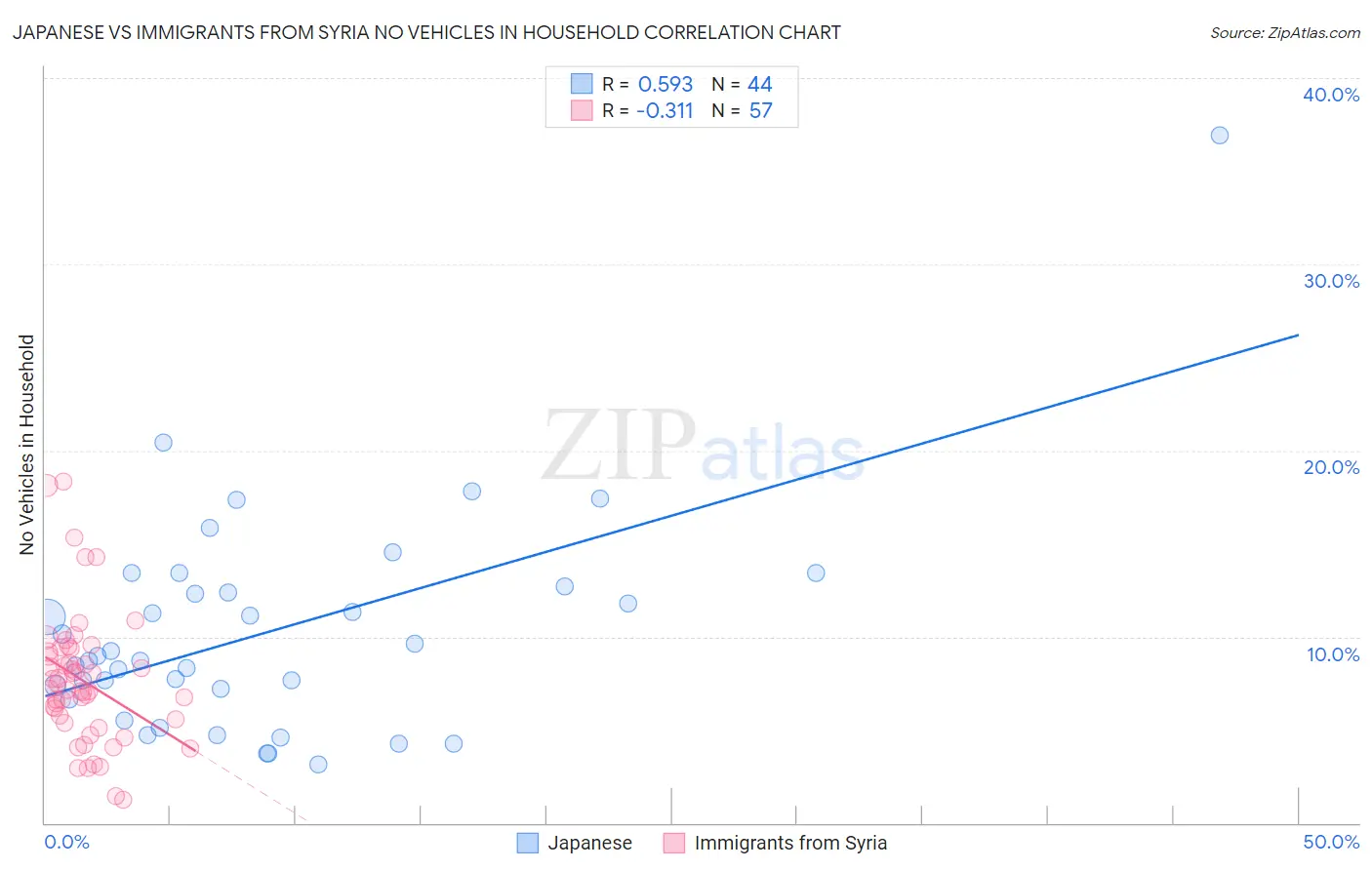Japanese vs Immigrants from Syria No Vehicles in Household
COMPARE
Japanese
Immigrants from Syria
No Vehicles in Household
No Vehicles in Household Comparison
Japanese
Immigrants from Syria
9.4%
NO VEHICLES IN HOUSEHOLD
94.1/ 100
METRIC RATING
116th/ 347
METRIC RANK
9.6%
NO VEHICLES IN HOUSEHOLD
89.5/ 100
METRIC RATING
128th/ 347
METRIC RANK
Japanese vs Immigrants from Syria No Vehicles in Household Correlation Chart
The statistical analysis conducted on geographies consisting of 248,891,204 people shows a substantial positive correlation between the proportion of Japanese and percentage of households with no vehicle available in the United States with a correlation coefficient (R) of 0.593 and weighted average of 9.4%. Similarly, the statistical analysis conducted on geographies consisting of 173,957,909 people shows a mild negative correlation between the proportion of Immigrants from Syria and percentage of households with no vehicle available in the United States with a correlation coefficient (R) of -0.311 and weighted average of 9.6%, a difference of 2.3%.

No Vehicles in Household Correlation Summary
| Measurement | Japanese | Immigrants from Syria |
| Minimum | 3.2% | 1.2% |
| Maximum | 36.9% | 18.3% |
| Range | 33.7% | 17.1% |
| Mean | 10.2% | 7.6% |
| Median | 8.9% | 7.2% |
| Interquartile 25% (IQ1) | 6.9% | 5.5% |
| Interquartile 75% (IQ3) | 12.6% | 9.3% |
| Interquartile Range (IQR) | 5.6% | 3.8% |
| Standard Deviation (Sample) | 5.9% | 3.5% |
| Standard Deviation (Population) | 5.8% | 3.5% |
Demographics Similar to Japanese and Immigrants from Syria by No Vehicles in Household
In terms of no vehicles in household, the demographic groups most similar to Japanese are Navajo (9.4%, a difference of 0.070%), Serbian (9.4%, a difference of 0.13%), Chippewa (9.4%, a difference of 0.17%), Immigrants from Netherlands (9.4%, a difference of 0.56%), and Armenian (9.4%, a difference of 0.66%). Similarly, the demographic groups most similar to Immigrants from Syria are Nicaraguan (9.7%, a difference of 0.030%), Immigrants from Kenya (9.6%, a difference of 0.080%), Icelander (9.6%, a difference of 0.27%), Burmese (9.7%, a difference of 0.28%), and Immigrants from Cameroon (9.6%, a difference of 0.43%).
| Demographics | Rating | Rank | No Vehicles in Household |
| Armenians | 95.0 /100 | #112 | Exceptional 9.4% |
| Immigrants | Netherlands | 94.8 /100 | #113 | Exceptional 9.4% |
| Serbians | 94.3 /100 | #114 | Exceptional 9.4% |
| Navajo | 94.2 /100 | #115 | Exceptional 9.4% |
| Japanese | 94.1 /100 | #116 | Exceptional 9.4% |
| Chippewa | 93.8 /100 | #117 | Exceptional 9.4% |
| Greeks | 92.9 /100 | #118 | Exceptional 9.5% |
| Fijians | 92.7 /100 | #119 | Exceptional 9.5% |
| Immigrants | Thailand | 92.6 /100 | #120 | Exceptional 9.5% |
| Puget Sound Salish | 92.4 /100 | #121 | Exceptional 9.5% |
| Costa Ricans | 92.3 /100 | #122 | Exceptional 9.5% |
| Blackfeet | 91.4 /100 | #123 | Exceptional 9.6% |
| Immigrants | Korea | 90.9 /100 | #124 | Exceptional 9.6% |
| Immigrants | Cameroon | 90.6 /100 | #125 | Exceptional 9.6% |
| Icelanders | 90.2 /100 | #126 | Exceptional 9.6% |
| Immigrants | Kenya | 89.7 /100 | #127 | Excellent 9.6% |
| Immigrants | Syria | 89.5 /100 | #128 | Excellent 9.6% |
| Nicaraguans | 89.5 /100 | #129 | Excellent 9.7% |
| Burmese | 88.8 /100 | #130 | Excellent 9.7% |
| Immigrants | Azores | 88.2 /100 | #131 | Excellent 9.7% |
| Kenyans | 88.0 /100 | #132 | Excellent 9.7% |